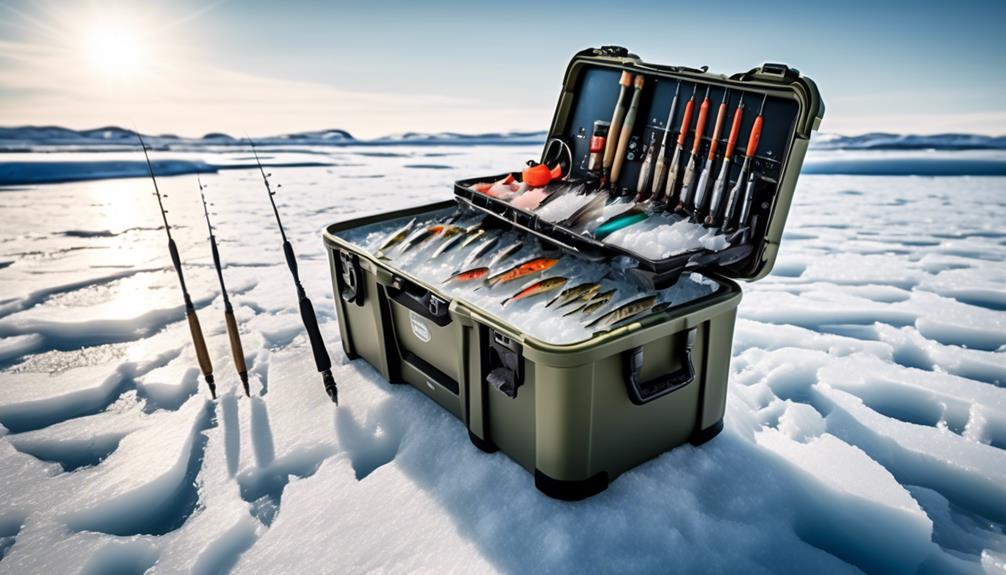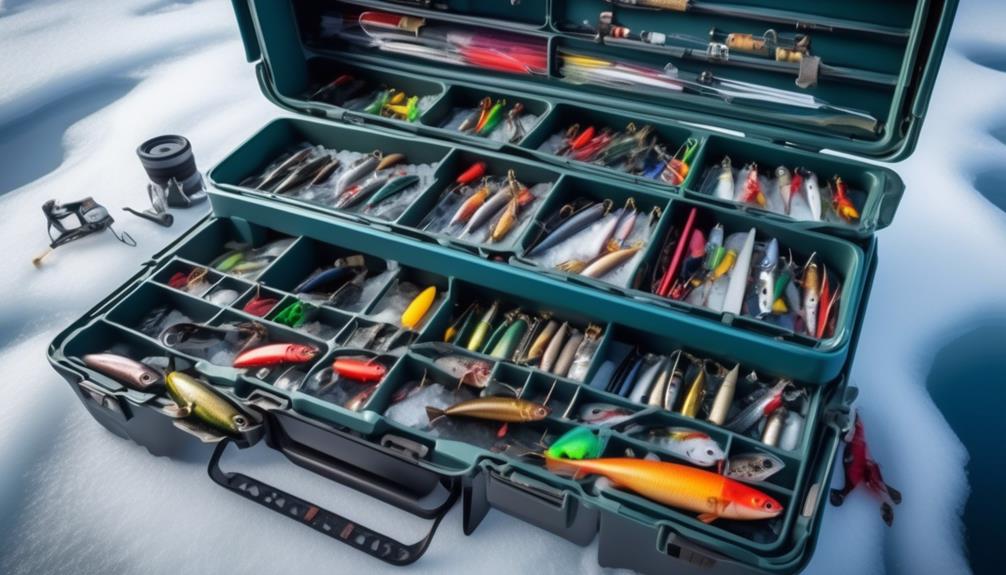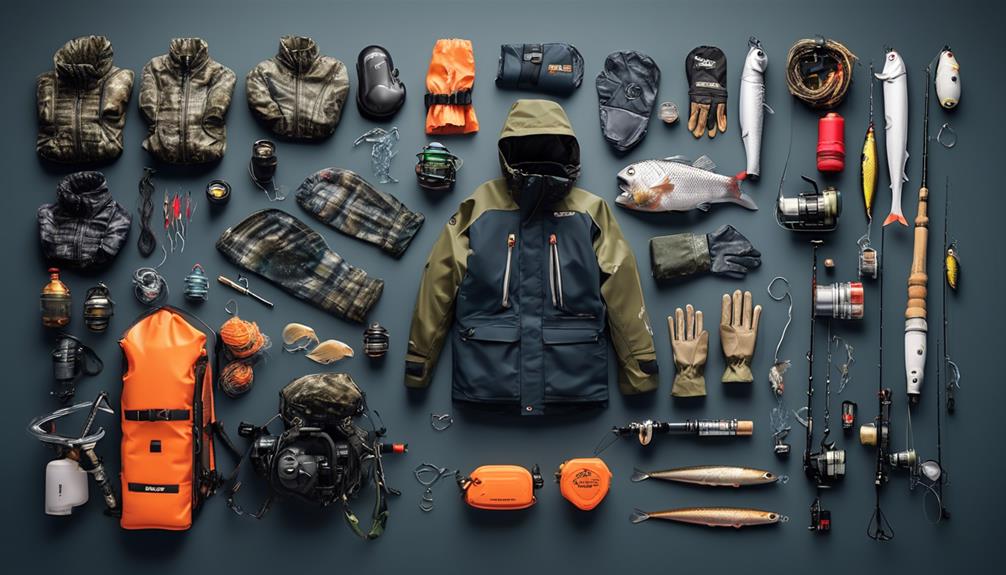You might think that getting out on the ice with just a fishing rod and some bait is all you need for a successful ice fishing trip, but there's a lot more to it than that.
As you prepare for your next ice fishing adventure, there are a number of essential gear and tackle insights that can make all the difference in your experience. From specialized rods and reels to crucial safety gear and electronics, each piece of equipment plays a significant role in your success on the ice.
Whether you're a seasoned angler or new to the ice fishing scene, understanding the importance of these essentials is key to maximizing your time and catching more fish.
Ice Fishing Rods
When choosing ice fishing rods, consider the flexibility and sensitivity needed for detecting bites in cold water conditions. The materials of the rod play a crucial role in its performance. Look for rods made from materials like fiberglass or graphite. Fiberglass rods are durable and less prone to breaking in freezing temperatures, while graphite rods offer greater sensitivity, allowing you to feel even the subtlest of bites. A good compromise could be a rod that combines both materials, offering the best of both worlds.
In terms of rod length, shorter rods, typically around 24 to 30 inches, are more suitable for fishing in tight quarters or when targeting smaller fish. They also provide better control when fighting a fish and are generally more portable. On the other hand, longer ice fishing rods, ranging from 28 to 36 inches, are better for detecting light bites and provide a longer casting distance. Consider the specific fishing conditions and target species when selecting the appropriate rod length.
It's important to note that while materials and length are critical factors, personal preference and fishing style also play a significant role in choosing the right ice fishing rod for you. Experimenting with different combinations of materials and lengths will help you find the perfect rod that suits your needs and enhances your ice fishing experience.
Reels and Line
To select the appropriate ice fishing reel and line, consider the specific requirements of your target fish and the depth of the fishing area. When it comes to reel selection, opt for an ice fishing reel that's designed to withstand frigid temperatures and has a smooth drag system. Look for reels with a high-quality drag that can handle the sudden bursts of energy from aggressive fish. Additionally, choose a reel size that matches the line capacity needed for your target species and the depth you'll be fishing at.
Line maintenance is crucial for successful ice fishing. Ensure that your line is in good condition by checking for any signs of wear and tear, such as nicks or abrasions. Replace any damaged line to prevent it from breaking during a crucial moment. In terms of line visibility, consider using a high-visibility line to help detect subtle bites, especially in low-light conditions. This can significantly improve your strike detection, leading to more successful hooksets.
Adjusting reel drag settings is essential for landing fish successfully. Set the drag to accommodate the strength and fighting ability of your target species. A good rule of thumb is to set the drag just tight enough to prevent line overruns while still allowing the fish to take line when it makes a strong run. This delicate balance is crucial for preventing line breakage and ensuring a successful catch.
Lures and Baits
Consider the type of lures and baits that will complement your chosen reel and line setup, as this will directly impact your success in ice fishing. When selecting lures and baits for ice fishing, it's essential to understand the behavior of the bait and how it will be presented in the water. Here are some insights to help you make the right choices:
- Bait Selection: The type of bait you choose is crucial. Live bait such as minnows, worms, or larvae can be very effective in attracting fish. Artificial baits like jigs, spoons, and soft plastics also work well. Consider the species you're targeting and the water conditions to determine the best bait selection.
- Lure Presentation: Ice fishing techniques require a different approach compared to traditional open water fishing. Understanding how to present your bait is key. For example, when using jigs, mastering the up and down movements is important to mimic the natural behavior of prey. Additionally, paying attention to the speed of retrieval and the depth at which the bait is presented can greatly impact your catch.
- Bait Behavior: Knowing how the bait will behave underwater is essential. For live bait, understanding how it moves and behaves in the water will help you attract fish. With artificial baits, consider the action they produce and how they imitate the movement of real prey. Observing bait behavior and adjusting your technique accordingly can significantly improve your ice fishing success.
Shelter and Clothing
Make sure to dress warmly and bring appropriate shelter for ice fishing to stay comfortable and safe in the cold environment.
Layering clothing is essential for staying warm during ice fishing. Start with a moisture-wicking base layer to keep sweat away from your body. Next, add an insulating layer such as a fleece jacket or wool sweater to trap heat. Finally, wear a waterproof and windproof outer layer to protect against the elements. This layering system allows you to adjust your clothing according to your activity level and the weather conditions.
In addition to layering clothing, insulated boots are crucial for keeping your feet warm and dry. Look for boots with thick insulation and a waterproof exterior to protect against the cold and potential exposure to water on the ice. Proper insulation will help retain heat while the waterproofing keeps moisture out. It's also important to ensure that the boots provide good traction to prevent slipping on the ice.
When it comes to shelter, a portable ice fishing shelter or ice tent can provide protection from the wind and cold temperatures. These shelters come in various sizes and styles, offering options for solo anglers or groups. Many shelters are designed with insulated fabric to retain heat, and some even feature built-in floors to provide an additional barrier against the icy ground.
Ice Augers
When drilling through ice for ice fishing, use a sharp and reliable ice auger to create holes with ease and efficiency. Ice augers come in various sizes and styles, and it's important to choose the right one for your needs. Here are some insights to consider when it comes to ice augers:
- Choosing the Right Ice Auger Size and Style
When selecting an ice auger, consider the ice thickness and the fish species you're targeting. For thicker ice or larger fish, a power auger might be more suitable due to its ability to cut through the ice more quickly. On the other hand, if you prefer a more traditional approach or anticipate drilling through thinner ice, a manual auger could be a practical choice. Additionally, some anglers prefer gas-powered augers for their convenience, while others opt for electric augers for their quieter operation and low maintenance.
- Ice Auger Maintenance and Troubleshooting
Proper maintenance is crucial to keep your ice auger in top condition. Regularly sharpen the blades to ensure efficient cutting and extend the auger's lifespan. Inspect the engine, if applicable, and other components for any wear and tear. Additionally, familiarize yourself with troubleshooting techniques in case the auger malfunctions during your ice fishing trip. Being prepared to address common issues such as engine starting problems or blade jams can save you time and frustration on the ice.
Safety Gear
Using appropriate safety gear is essential for ensuring a secure and enjoyable ice fishing experience. When venturing onto the ice, it's crucial to have the right equipment to keep you safe in case of emergencies. Ice picks are indispensable tools for self-rescue if you were to fall through the ice. These handheld devices feature sharp metal spikes that can be used to grip the ice and pull yourself out of the water. It's important to keep them accessible, either by wearing them around your neck or storing them in a readily accessible pocket. Safety ropes are another vital component of ice fishing safety. They're used for rescuing others who may have fallen through the ice, providing a means to pull them to safety without putting yourself at risk.
In addition to ice picks and safety ropes, it's wise to carry an emergency blanket in your gear. These lightweight, compact blankets are designed to retain body heat and provide protection from the elements in case of an unexpected overnight stay on the ice. Furthermore, having a first aid kit readily available can be a lifesaver in the event of minor injuries or accidents. Your first aid kit should include essentials such as bandages, antiseptic wipes, pain relievers, and any personal medications you may need.
When it comes to ice fishing, safety should always be a top priority. By being prepared with the right safety gear, you can enjoy your ice fishing adventures with peace of mind, knowing that you're equipped to handle unexpected situations.
Electronics and Tools

Equipped with the essential safety gear for your ice fishing expedition, now it's time to focus on the electronics and tools that can enhance your experience on the ice. Here are some essential electronics and tools you should consider bringing along:
- Fish Finders and Depth Finders: These devices are invaluable for locating fish and determining the depth of the water beneath the ice. They use sonar technology to provide real-time information, helping you identify the most promising spots to set up your gear.
- GPS Devices: A reliable GPS can be a lifesaver on the ice, especially in unfamiliar territory. It not only helps you find your way back to your starting point but can also mark productive fishing locations for future reference.
- Digital Thermometers: It's crucial to monitor the water temperature while ice fishing, as it directly affects fish behavior. A digital thermometer allows you to quickly and accurately assess the water temperature at different depths, helping you adjust your fishing strategy accordingly.
In addition to these electronics, there are several essential tools to pack for your ice fishing trip:
- Ice Picks and Ice Scoops: These are vital for clearing and testing the ice as you move across it.
- Flashlights: As daylight wanes, a reliable flashlight becomes essential for safety and visibility.
- Tackle Boxes, Rod Holders, and Tip Ups: These tools help keep your fishing gear organized and secure, maximizing your chances of success on the ice.
Accessories and Storage
Considering your ice fishing expedition, it's important to carefully choose the right accessories and storage solutions to ensure a successful and organized experience on the ice.
Tackle organization plays a crucial role in maximizing your efficiency on the frozen water. Invest in a durable tackle box or bag designed to withstand the harsh conditions of ice fishing. Look for options with multiple compartments and adjustable dividers to keep your lures, hooks, and jigs neatly organized and easily accessible. This won't only save time but also protect your gear from getting tangled or damaged.
Gear protection is paramount when it comes to ice fishing. Ensure that your valuable equipment is stored in a reliable and insulated container. Ice fishing can subject your gear to extreme temperatures, so a quality equipment case will shield your rods, reels, and other essentials from the elements.
Additionally, proper gear maintenance is essential for longevity and peak performance. Carry a small toolkit with essential items such as pliers, line clippers, and a hook sharpener to address any on-the-go equipment maintenance needs. Regularly check your gear for signs of wear and tear, and promptly address any issues to prevent potential malfunctions while on the ice.
Frequently Asked Questions
What Are the Best Tips for Finding the Most Productive Ice Fishing Spots?
When ice fishing, finding productive spots is key. Use techniques like drilling test holes to check depth and fish activity. Pay attention to fish behavior – look for signs like suspended fish or schools on your sonar.
Underwater topography matters – focus on drop-offs, points, and weed beds. These areas often attract fish. Remember, successful spot selection is a combination of observation and understanding the underwater environment.
How Can I Properly Maintain My Ice Fishing Equipment to Ensure Longevity and Performance?
To maintain your ice fishing gear for longevity and peak performance, there are a few key steps to follow. First, it's important to regularly clean and dry your equipment after each use. This will help prevent any build-up of dirt or moisture that could lead to damage or rust.
Next, make sure to store your gear in a cool, dry place. This will further protect it from rust and other forms of damage. It's also a good idea to inspect your rods, reels, and lines for any signs of wear and tear. If you notice any damaged parts, be sure to replace them promptly to avoid further problems.
Another important aspect of gear maintenance is keeping your ice auger blades sharp and clean. Dull or dirty blades can make drilling holes in the ice more difficult and can also potentially damage your auger. Regularly sharpening and cleaning the blades will help ensure that they perform at their best.
What Are Some Common Mistakes to Avoid When Setting up an Ice Fishing Shelter?
When setting up an ice fishing shelter, there are a few key considerations to keep in mind.
First, it's important to choose a safe location. Avoid placing your shelter in areas with weak ice or near potential hazards. This will help ensure your safety while you're out on the ice.
Second, make sure your shelter is well-anchored and protected from strong winds. Ice fishing shelters can be easily blown away if not properly secured. Taking the time to anchor it securely will prevent any unpleasant surprises during your fishing trip.
Third, proper insulation is essential for keeping warm in your shelter. Make sure to insulate your shelter effectively to retain heat. This will help you stay comfortable and enjoy your time on the ice.
Lastly, be mindful of condensation buildup in your shelter. Use ventilation techniques to prevent excessive condensation, as it can lead to discomfort and even damage your equipment.
How Can I Effectively Prepare for an Emergency Situation While Ice Fishing?
To effectively prepare for an emergency situation while ice fishing, safety measures are key.
- Always carry a fully charged phone and a first aid kit.
- Check the weather forecast and inform someone about your location and expected return time.
- Carry ice picks and a throw rope for self-rescue.
- Wear a flotation suit or life jacket and avoid going alone.
- Familiarize yourself with the ice conditions and always be cautious.
Are There Any Specific Regulations or Guidelines to Follow When Ice Fishing in Different Locations?
When ice fishing in different locations, it's crucial to understand the specific regulations and safety guidelines. These rules ensure the protection of the environment and conservation efforts.
Always check local authorities for any restrictions on fish species, catch limits, and ice thickness requirements. Additionally, be aware of any safety guidelines regarding ice conditions, weather forecasts, and emergency preparedness.
Following these regulations and guidelines is essential for a successful and safe ice fishing experience.
Conclusion
Now that you've got the essential ice fishing gear and tackle insights, you're ready to hit the ice and reel in some big catches.
Remember to stay safe, dress warmly, and keep your gear organized.
With the right equipment and preparation, you'll have a successful and enjoyable ice fishing experience.
Good luck out on the ice!



